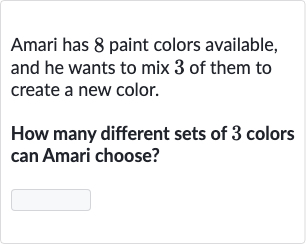Full solution
Q. Amari has paint colors available, and he wants to mix of them to create a new color.How many different sets of colors can Amari choose?
- Identify Problem Type: Identify the type of problem.We need to find the number of combinations of colors that can be chosen from colors. This is a combinatorics problem, specifically a combination problem where order does not matter.
- Use Combination Formula: Use the combination formula to calculate the number of different sets.The number of ways to choose items from is given by the combination formula: , where is the total number of items, is the number of items to choose, and “” denotes factorial.
- Plug in Values: Plug in the values into the combination formula.Here, (total colors) and (colors to choose). So, we calculate .
- Simplify Factorials: Simplify the factorial expressions.Calculate , , and .
- Cancel Common Terms: Cancel out common terms in the numerator and the denominator..The in the numerator and denominator cancel out, and we are left with:.
- Perform Calculation: Perform the calculation..
More problems from Counting principle
QuestionGet tutor help
QuestionGet tutor help
QuestionGet tutor help
QuestionGet tutor help
QuestionGet tutor help
QuestionGet tutor help
QuestionGet tutor help
QuestionGet tutor help
QuestionGet tutor help

